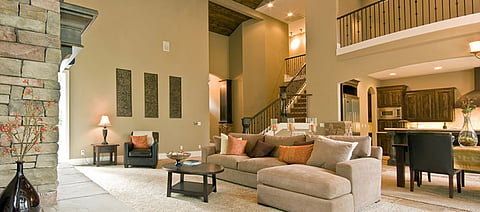2 ways lighting can affect paint colour on your walls
Lighting can make or break the look of your chosen paint colour. Natural light shifts throughout the day and, depending on the room’s orientation, can dramatically influence the warmth, depth, and vibrancy of a colour. Meanwhile, artificial lighting, through its temperature and intensity, can either complement or distort your colour choice.
Choose wall paint depending on these two factors
When selecting paint colours for a room, many people rely solely on the colour swatch or sample in-store, only to find that it looks completely different once applied at home. This often frustrating change is usually due to one crucial factor: lighting.
Light plays a significant role in how we perceive colour, and it can dramatically alter the appearance of paint depending on various conditions. Both natural and artificial light sources interact with pigments in complex ways, influencing everything from brightness to undertones.
Note how natural light interacts with the room
One of the most significant ways lighting affects paint colour is through the shifting nature of natural daylight. The same room painted in one colour can look entirely different at different times of day due to the position of the sun and the type of daylight filtering in.
In East-facing rooms early sunlight will have a cool, bluish tint. In rooms that face east, colours may appear sharper or cooler in the morning and become more muted later in the day. A soft grey might feel crisp and modern in the morning but dull by afternoon.
South-facing rooms, receive the most consistent and warm natural light during mid-day. This tends to enhance colours, making them appear brighter and more vibrant. Warm tones such as yellows, creams, and light browns flourish in this setting, while cooler tones like blues and greens may feel slightly warmer.
West-facing spaces often experience warm, golden light in the late afternoon and evening. This can enrich colours, particularly warm tones, making them glow.
Understanding the orientation of a room and how light changes over the course of the day is crucial when selecting a paint colour. That’s why it’s highly recommended to test paint swatches on different walls and observe them at various times to see how natural light affects their appearance.
Artificial lighting and colour temperature
Artificial lighting is another major factor that influences paint colour. Light bulbs come in various colour temperatures, which can dramatically alter how a paint colour appears, particularly at night or in windowless rooms.
Incandescent and halogen lighting are light sources that emit a warm, yellowish light. They tend to enhance warm colours like reds, oranges, and yellows, making them feel even cosier.
Fluorescent lightings is found in offices or kitchens, fluorescent lights emit a cooler, bluish light. This can intensify cooler shades while making warm tones look washed out or flat. For instance, a beige might take on a pinkish cast, while a white may look slightly blue.
LED Lighting is available in a wide range of temperatures, from warm white to cool daylight. This flexibility makes them ideal for experimenting with colour perception. A cool white LED may make a navy wall look crisp and deep, while a warm white LED can soften it significantly.

